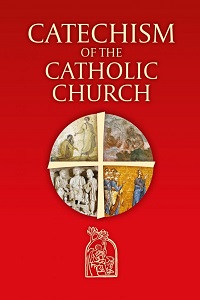How will these resources help you?
One short and succinct Bible quote that is often taught to support Catholic teaching on contraception is ‘be fruitful and multiply’ (Genesis 1:28). However, as you would expect, there is much more to Catholic teaching on the matter beyond these four words of scripture. As RE teachers, it is useful to teach beyond the short quotes to allow students the opportunity to gain a fuller understanding of the faith and how it is lived by Catholics today. Catholics have three sources of authority that guide their conscience: scripture, tradition and magisterium. Referring to more than just scripture will allow teachers to present Catholicism more accurately, and to encourage discussion among students.
Official Catholic teaching about contraception

Catechism of the Catholic Church: The CTS Definitive and Complete Edition
published by Catholic Truth Society, (2022), 9781784691066
The Catechism is a great resource for looking up official Catholic teachings to use in lessons to support any topics being studied. It is written by the magisterium (official teaching authority of the Church) and is therefore an important source of authority, trusted by Catholics to inform their conscience on belief, practice and morality. In section 2366–2372 you will find the assertion that the two purposes of sex are to create new life and to unite the couple. Anything therefore which deliberately and artificially violates this is against moral law. However, in 2368 it recognises that ‘spouses may wish to space the births of their children’ and recommends natural methods for this as long as the reasons for this are just and not selfish. Natural family planning (NFP) is considered part of responsible parenthood and not in violation of moral law since the couple works with nature not against it.
How can the church say that contraception is damaging to society?

Humanae Vitae
by Pope Paul VI, published by the Vatican, (1968)
In Catholic tradition, popes might write encyclicals (letters) to address concerns of the day. With the contraceptive pill becoming available to women in the 1960s, Pope Paul VI wrote to Catholics to express the Catholic teaching in this context and warn of the damage it could do. He reasserted the dignity of human sexuality and that sex should be marital, procreative and unitive. He then stated that using contraception could lead to a loss of morality and a loss of respect for women through objectification (because sex with contraception avoids burdening the couple with unwanted children). This could be a great scholarly resource to prompt discussion in the classroom – students could discuss questions such as ‘Can casual sex be damaging to a person?’ or ‘Is it ok for people to have sex purely for pleasure?’ where they put the Pope’s teachings to the test.
What about contraception to avoid disease?

Analysis: What the Pope really said about condoms
by Alan Holdren, published by Catholic News Agency, (2010)
In 2010, the media reported that Pope Benedict XVI had said that contraception could be used if it was to avoid transmission of HIV infections. However, this article explains what was actually stated by Pope Benedict in his interview. While he was agreeing that the transmission of infection is unacceptable, he made the point that instead of using contraception to avoid this, people should consider it wrong to use a person for sex in the first place. This links to the Catechism teachings that sex should be marital, procreative and unitive. The Pope was reasserting the teaching of the dignity of the human body in his calling for the ‘humanization of sexuality’. This article would challenge students to apply their knowledge of Catholic teaching on contraception to the problem of sexually transmitted infections. They could discuss why the Church would still teach that contraception is wrong even if it prevents suffering and evaluate how useful this teaching is to Catholics today.
Do Catholics today follow the church’s teachings on contraception?

Is Catholic teaching on birth control driving people from the pews?
by Ryan Burge, published by Religion News Service, (2023)
In RE, not only do we teach a religion’s beliefs but also how the religion is practised. It is therefore interesting to consider sociological data on topics to see how Catholicism is lived in today’s world. This article says that ‘it’s clear from this data that there is a tremendous disconnect between the Vatican’s teaching on contraception and the behavior of more than 60 million Catholics in the United States’ and the findings show that Catholics do use artificial contraception methods in reality. It would be interesting for students to consider why some Catholics might not follow official teachings on contraception by linking their knowledge to their understanding of beliefs about creation, for example by discussing whether ‘the environmental damage of overpopulation means Catholics should use contraception’.
Further materials
Catholicism: A Very Short Introduction by Gerald O’Collins, published by Oxford University Press, (2008), 9780199545919
Find this book
Applying Natural Law to Contraception by Patrick Coffin, published by St. Paul Center for Biblical Theology, (2018)
Read this article
Pope Francis on birth control: Can the teaching of the Church on contraception change? by Courtney Mares, published by The Catholic World Report, (2022)
Read this article
Jennifer Knight is Head of RE in a Catholic school where she teaches AQA Syllabus B and has previously taught AQA Syllabus A in non-faith schools.
Text © Jennifer Knight, 2023.
Text © Jennifer Knight, 2023.



